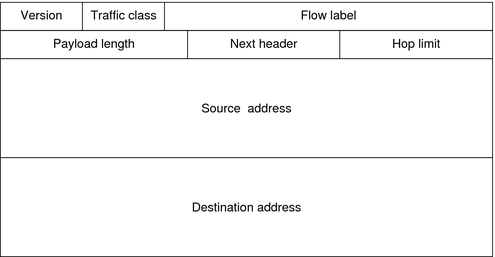| Skip Navigation Links | |
| Exit Print View | |

|
System Administration Guide: IP Services Oracle Solaris 11 Express 11/10 |
| Skip Navigation Links | |
| Exit Print View | |

|
System Administration Guide: IP Services Oracle Solaris 11 Express 11/10 |
1. Planning an IPv4 Addressing Scheme (Tasks)
2. Planning an IPv6 Addressing Scheme (Overview)
3. Planning an IPv6 Network (Tasks)
4. Configuring TCP/IP Network Services and IPv4 Addressing (Tasks)
5. Enabling IPv6 on a Network (Tasks)
6. Administering a TCP/IP Network (Tasks)
8. Troubleshooting Network Problems (Tasks)
9. TCP/IP and IPv4 in Depth (Reference)
IPv6 Addressing Formats Beyond the Basics
6to4-Derived Addressing on a Host
IPv6 Multicast Addresses in Depth
Oracle Solaris IPv6 Implementation
/etc/inet/ipaddrsel.conf Configuration File
netstat Command Modifications for IPv6 Support
snoop Command Modifications for IPv6 Support
route Command Modifications for IPv6 Support
ping Command Modifications for IPv6 Support
traceroute Command Modifications for IPv6 Support
in.ndpd Daemon, for Neighbor Discovery
in.ripngd Daemon, for IPv6 Routing
inetd Daemon and IPv6 Services
IPv6 Neighbor Discovery Protocol
ICMP Messages From Neighbor Discovery
Obtaining a Router Advertisement
Prefix Configuration Variables
Neighbor Solicitation and Unreachability
Duplicate Address Detection Algorithm
Comparison of Neighbor Discovery to ARP and Related IPv4 Protocols
IPv6 Extensions to Oracle Solaris Name Services
Changes to the nsswitch.conf File
Changes to Name Service Commands
12. Planning for DHCP Service (Tasks)
13. Configuring the DHCP Service (Tasks)
14. Administering DHCP (Tasks)
15. Configuring and Administering the DHCP Client
16. Troubleshooting DHCP (Reference)
17. DHCP Commands and Files (Reference)
18. IP Security Architecture (Overview)
20. IP Security Architecture (Reference)
21. Internet Key Exchange (Overview)
23. Internet Key Exchange (Reference)
24. IP Filter in Oracle Solaris (Overview)
Part IV Networking Performance
26. Integrated Load Balancer Overview
27. Configuration of Integrated Load Balancer Tasks
28. Virtual Router Redundancy Protocol (Overview)
29. VRRP Configuration (Tasks)
30. Implementing Congestion Control
Part V IP Quality of Service (IPQoS)
31. Introducing IPQoS (Overview)
32. Planning for an IPQoS-Enabled Network (Tasks)
33. Creating the IPQoS Configuration File (Tasks)
34. Starting and Maintaining IPQoS (Tasks)
35. Using Flow Accounting and Statistics Gathering (Tasks)
The IPv6 protocol defines a set of headers, including the basic IPv6 header and the IPv6 extension headers. The following figure shows the fields that appear in the IPv6 header and the order in which the fields appear.
Figure 10-3 IPv6 Basic Header Format

The following list describes the function of each header field.
Version – 4-bit version number of Internet Protocol = 6.
Traffic class – 8-bit traffic class field.
Flow label – 20-bit field.
Payload length – 16-bit unsigned integer, which is the rest of the packet that follows the IPv6 header, in octets.
Next header – 8-bit selector. Identifies the type of header that immediately follows the IPv6 header. Uses the same values as the IPv4 protocol field.
Hop limit – 8-bit unsigned integer. Decremented by one by each node that forwards the packet. The packet is discarded if the hop limit is decremented to zero.
Source address – 128 bits. The address of the initial sender of the packet.
Destination address – 128 bits. The address of the intended recipient of the packet. The intended recipient is not necessarily the recipient if an optional routing header is present.
IPv6 options are placed in separate extension headers that are located between the IPv6 header and the transport-layer header in a packet. Most IPv6 extension headers are not examined or processed by any router along a packet's delivery path until the packet arrives at its final destination. This feature provides a major improvement in router performance for packets that contain options. In IPv4, the presence of any options requires the router to examine all options.
Unlike IPv4 options, IPv6 extension headers can be of arbitrary length. Also, the number of options that a packet carries is not limited to 40 bytes. This feature, in addition to the manner in which IPv6 options are processed, permits IPv6 options to be used for functions that are not practical in IPv4.
To improve performance when handling subsequent option headers, and the transport protocol that follows, IPv6 options are always an integer multiple of 8 octets long. The integer multiple of 8 octets retains the alignment of subsequent headers.
The following IPv6 extension headers are currently defined:
Routing – Extended routing, such as IPv4 loose source route
Fragmentation – Fragmentation and reassembly
Authentication – Integrity and authentication, and security
Encapsulating Security Payload – Confidentiality
Hop-by-Hop options – Special options that require hop-by-hop processing
Destination options – Optional information to be examined by the destination node